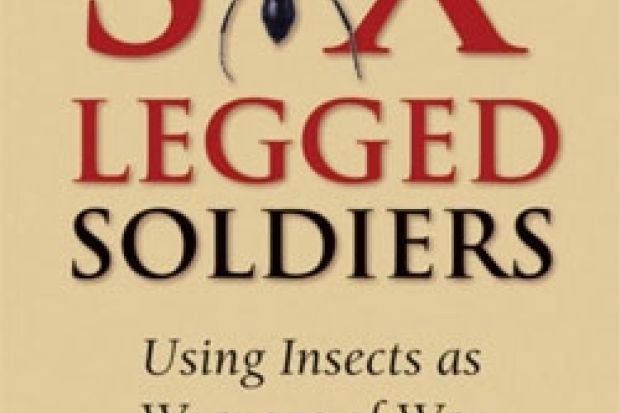For the entomologically naive, Six-Legged Soldiers: Using Insects as Weapons of War may serve as a terrifying insight into the destructive potential of insects, and an alternative perspective on some key events in history. Jeffrey Lockwood traces the role of insects in hostilities and warfare through time, and evaluates their potential for exploitation in both beneficial and malicious undertakings in the future.
Early entomological warfare involved hurling bees and wasps in nests or inanimate objects as deterrents to invaders. The use of catapulted beehives as a means of attack and defence between 1000 and 1300 is reported by Lockwood to have contributed to a documented decline in the numbers of these beneficial insects, such was its popularity.
But the harnessing of their painful potential also highlighted what would be one of the greatest limitations of the use of insects in warfare: they were difficult to control and there was no guarantee that one's ultimate six-legged weapon would not turn traitor on its own "allies". This potential for insects to cause disease and suffering among one's own troops or civilians has been the impetus for greater understanding of insect behaviour and vector ecology.
The weaponry potential of the insect is perhaps greatest as a vector, and in wartime, when hygiene and medical considerations suffer, insects flourish alongside human adversity. Lockwood documents the role of insect-borne diseases such as typhus, yellow fever, malaria and bubonic plague in battles throughout history, and rightly concludes that "the proboscis proved mightier than the sword".
In the US Civil War, insects killed more soldiers than did firearms and cannon, and this was common in battles until military forces gained the entomological insight to treat their soldiers, either by vaccinating them against disease or preventing the vector from taking hold among their troops. The role of insects here was not intended, but a mere consequence of both circumstances and their great success in exploiting an ideal situation.
The use of insects to inflict pain has been greatly explored, often under the pretence of defence and a need to be prepared for enemy attack, yet it has inevitably evolved to meet offensive goals. Lockwood explores in detail the role of Japanese Unit 731 in Manchuria during the Second World War. Under the leadership of General Shiro Ishii, numerous techniques of biological weaponry were trialled, many using insects for their dispersive behaviour and therefore their ability to spread disease rapidly. The unit's experimentation facility was concealed under the guise of a lumber mill, and human subjects were employed in some horrifying experiments to determine the potential of biological weapons.
Past events lead us to consider future possibilities, and the issue of biological terrorism is of great concern. Mass attacks on civilians using insect vectors are completely plausible and would be difficult to investigate, particularly where a species with vector capabilities is already present in a target population and the only missing link is the pathogen.
But one is left wondering whether efforts should be directed towards vector control or mass vaccination. Lockwood suggests that, in particular, the US agricultural industry is underprepared for a pest invasion, a situation that could result in huge economic losses and the possible introduction of pathogens in the process.
The book is an excellent read, but it is more focused on the scientific issues and the ethical quandaries they raise, as opposed to providing a historical narrative. In the current climate this is very topical, and Lockwood considers the latest frontiers such as robotics based on insects, and the training of honeybees to locate toxic substances, along with more traditional monitoring programmes to protect national borders and, consequently, citizens and industry.
History shows that exploitation of the natural behaviour of insects has led to some crushing blows against the enemy. Current trends in research appear outwardly to be addressing defensive capabilities using insects, and anticipating possible invasions and outbreaks. But given the diversity of insects, can we ever truly predict the next big threat? Six-Legged Soldiers provides a chronicle of insects in warfare, and serves as an ominous reminder of the hidden capabilities of our hexapod friends.
Six-Legged Soldiers: Using Insects as Weapons of War
Oxford University Press
400pp
£14.99
ISBN 9780195333053
Published 8 January 2009
Register to continue
Why register?
- Registration is free and only takes a moment
- Once registered, you can read 3 articles a month
- Sign up for our newsletter
Subscribe
Or subscribe for unlimited access to:
- Unlimited access to news, views, insights & reviews
- Digital editions
- Digital access to THE’s university and college rankings analysis
Already registered or a current subscriber? Login
